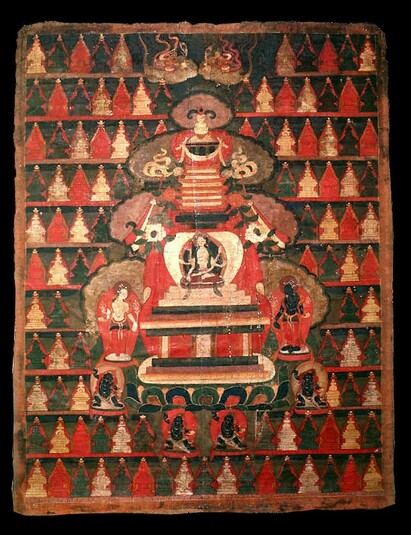
Item: Ushnishavijaya (Buddhist Deity)
| Origin Location | Tibet |
|---|---|
| Date Range | 1600 - 1699 |
| Lineages | Uncertain |
| Material | Ground Mineral Pigment on Cotton |
| Collection | Southern Alleghenies Museum of Art |
Classification: Deity
Ushnishavijaya (Tibetan: tsug tor nam par gyal ma, English: The Victorious One of the Crown Protuberance) the goddess of long-life, seated inside a 'victory caitya,' surrounded by eight deities.
"Ushnishavijaya, the colour of an autumn moon; with three faces, white, yellow and blue and eight hands; each face has three very large eyes. The first right hand holds a visvavajra; second a white lotus with Amitabha residing; third, an arrow and fourth, in supreme generosity. The first left holds a vajra lasso; second, a bow; third, bestowing protection and fourth in meditative equipoise holding an auspicious nectar vase; complete with silks and jewel ornaments, seated in [vajra] posture.
On the right [of the caitya], above a moon is Avalokiteshvara with a body white in colour; the left hand holds a lotus. On the left [of the caitya], above a sun is Vajrapani, blue; the left hand holds an utpala with vajra; standing in a peaceful manner and adorned with silks and jewels." (Jamyang Kyentse Wangpo, 1820-1892).
Below are the four wrathful deities, blue Achala (Immovable) brandishing a sword in the right hand, blue Takkiraja (King of Desire) with a hook, blue Niladanda (Blue Stick) with a stick, and blue Mahabala (Great Strength) with a trident. With the left hands they perform the 'wrathful gesture' at the heart. They are adorned with jewels and snakes and wear lower garments of tiger skin. At the very top above the spire of the 'caitya' are two Devaputras (Sons of the Gods) holding nectar vases. The background of the painting is composed of a series of 108 small 'caityas' of alternating colours symbolizing the various enlightened activities.
The 'caitya,' historically a funerary mound for the remains of buddha Shakyamuni, is now seen as a geometric architectural model representing the enlightenment of the buddha as well as a blueprint for the very path to achieve enlightenment. Each feature of the model represents an aspect of Buddhist teaching and meditation which must be accomplished in order to obtain the ultimate result. From the view of the result, the model represents all the qualities of complete buddhahood. There are three basic elements of form; a square base which acts as a throne, above that is the round vase-like structure, and above that, the spire with multiple flat discs and adorned with a parasol and hanging pendants. There are eight common styles of 'caitya' construction representing eight acts of Shakyamuni Buddha.
Ushnishavijaya is often accompanied by the deities Amitayus and White Tara. Together they are known as the Three Long-life Deities. The practice is common to all Schools of Tibetan Buddhism. The style of painting along with the rich colours indicate a strong Southern Tibetan-Nepali influence.
J.Watt 6-98
Buddhist Deity: Ushnishavijaya & Stupa (Painting)
Collection of Southern Alleghenies Museum of Art
Buddhist Deity: Ushnishavijaya Main Page
Buddhist Deity: Deities (Female)
Collection of Southern Alleghenies: Deity
Subject: Composition - Repeated Figures Main Page
